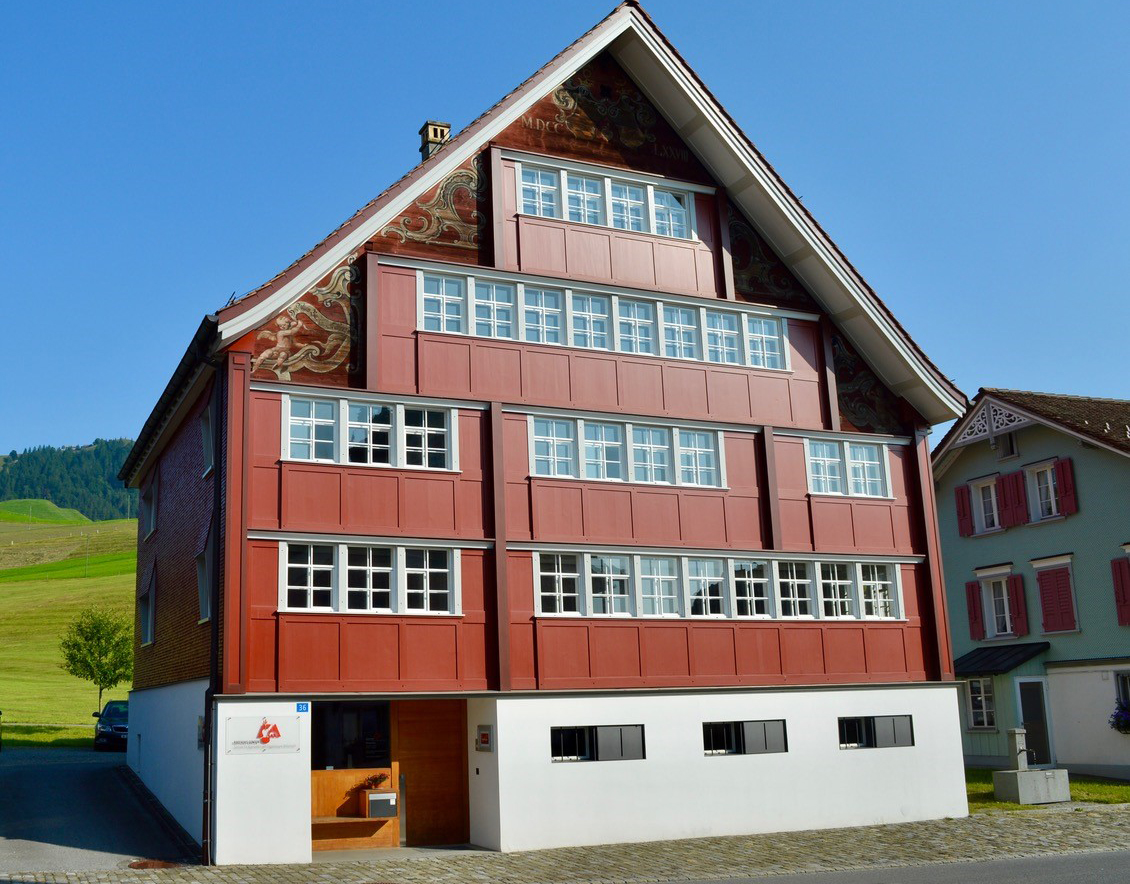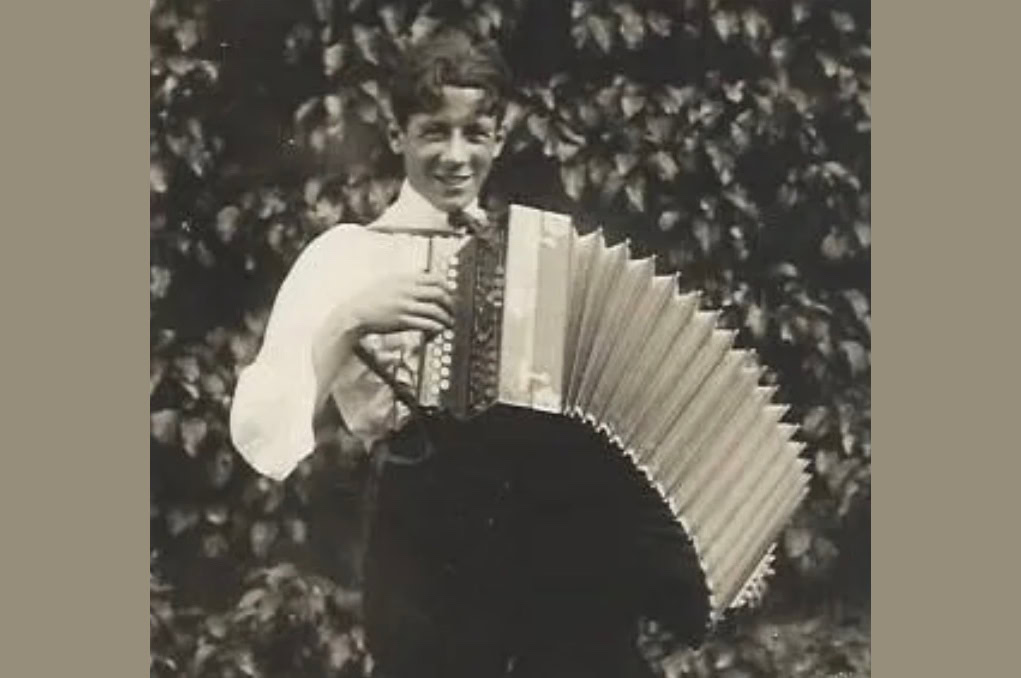Archive of the Roothuus Gonten digital
The Roothuus Gonten is home to thousands of instrumental and yodel pieces, one of the most important collections of folk music heritage in Switzerland. This treasure is increasingly accessible digitally and invites visitors to embark on multi-layered research trips.

Recently the Roothuus Gontenthe Center for Appenzell and Toggenburg Folk Music, has been richly endowed: With the sheet music collection of retired teacher Erwin Sager from Bühler, over 8000 instrumental and yodel pieces were transferred to the center. More than 5300 of these have already been recorded. They are available to interested folk music circles and the general public on folkmusic.ch accessible. The Roothuus operates this database together with the Altdorf House of folk music. The Roothuus Gonten server is home to an additional 15,500 supplementary files. In concrete terms, this means that for a single file stored on folkmusic.ch up to 30 additional variants can be discovered for each work found in the Gontner Archive!
The detailed press release issued by Roothuus Gonten on March 8 underlines the relevance of this collection for Switzerland and explains how the digital archive works.

Extraordinary density
At Roothuus Gonten, historical collections by Josef Peterer "Gehrseff", Carl Emil Fürstenauer, Heinrich Brenner, Johann Manser and others are displayed alongside collections of contemporary notation. Past and present enter into a creative dialogue; new notations are constantly being added and contextualized. Some of the historical sources also reappear in the Sager Collection. Between collecting, researching and cataloging, a dense network is created, an archive of sound. As a result, this collection is not only one of the richest repositories of folk music heritage in the Alpstein region, but is also regarded throughout Switzerland as a reference archive for the music of a more or less clearly defined region.
Erwin Sager
As a passionate collector, folk musician Erwin Sager is equipped with that Appenzell mixture of passion, inspiration and practice. Born in 1946, his interest in Appenzell music on the violin, viola, cello and bass has taken him halfway around the world. He also composed and documented diligently and built up a large collection of originals, variations and new versions of Appenzell and Toggenburg folk music over the decades. The public can now benefit from this far beyond the region's borders.
Favorable source situation
However, the Roothuus music collection is not only characterized by an impressive quantity of musical texts. It also offers a new research perspective, thanks to the professional sifting and cataloging of the material by the staff at the center itself. In contrast to other regions with mainly oral traditions, the people of Appenzell have always been very keen to document and write down their melodies. "With the new system, we can identify the oldest recorded source, create meaningful networks and add to the collection in digital or analog form. All of this is also thanks to the sheet music materials that can be physically viewed in the Roothuus," says Managing Director Barbara Betschart, herself a professional violinist with many years of experience at the interface between practice and research.
Playing with identities
Using the magic word *NSR* (Notensammlung Roothuus), interested parties can access the full-text search on folkmusic.ch a kind of four-dimensional space of memory. Access to the digital data is deliberately designed to be user-friendly (see quick guide at the end of this text). Now and again, however, exploring the music collection also requires its own form of investigative skill. It is very similar to the imaginative coordination of movements and listening when making music: combining, artistic links and historical references are often important for using the database.
"Not all compositions can be clearly categorized in terms of their identity. Sometimes the original melodies only formed the framework for numerous variants, sometimes they were expanded, supplemented with a second voice or they seemingly disappeared behind a newer, more powerful version," explains Betschart. The collection takes account of this variety of references and influences in the development of a work with countless details. This includes, for example, sheet music in PDF/XML formats or audio files and information on specific performance dates and locations. In addition to the assignments to the various dance forms (for example "1." for march, "2." for mazurka or "3." for polka etc.), which appear as the first number in the NSR catalog, there is a wealth of additional information on the origin, the notator including his nickname, occasionally the estate and - particularly exciting - the melody code, which can be used to find and assign a composition in the reverse case.

Sounding codes
*durrdurruuuuddddududur* - what seems like an archaic secret language is actually a decoding code with a simple melody recipe according to the international Parsons method: "u" means an ascending interval, "d" a descending one, an "r" symbolizes the repetition of the same note. Thanks to the sequence of letters, the approximate musical line can be traced. In the above example, entering the code in the search function reveals that the sheet of music in question is NSR.30069, the polka In the Rössli, z'Hondwilcomposed very probably by Jakob Anton Knill, nicknamed "Fleck" (1821-1892), who, however, did not notate any pieces of music himself. The transcription was probably written by Josef Anton Inauen "Badistesebedoni" (1821-1994), a musical colleague of Knill's in the Appenzell String Quartet. There are also interesting facts about the origin of the title: it was not added until 1929, when the piece was recorded on shellac by the Urnäscher Streichmusik.
Example: NSR. 30069
The discovery tour continues: for the third part of In the Rössli, z'Hondwil you can discover several variants from over 250 years in the collection of the Roothuus Gonten. Three of them provide an insight into the variability, style and historical melody design. The version of "Badistesebedoni" is probably the oldest source. All three variants are still played today.



Music of the future
There are currently several challenges: On the one hand, cataloging solutions are needed for the numerous natural yodels in the Sager collection, which have proven to be particularly challenging to record due to their small size. On the other hand, the center works as a non-profit organization of the following donors: Canton Appenzell Innerrhoden, Canton Appenzell Ausserrhoden, Canton St.Gallen, District Gonten and Appenzellische Gemeinnützige Gesellschaft. The Roothuus is also supported by various private sponsors. Rising user fees, the expensive storage space, additional work quotas and the high quality standards, including in the research context, demand additional resources, including financial resources, a great deal of idealism, energy and perseverance.
"The project will continue for quite some time and, given the source situation, there is no end in sight. This is inspiring, but remains a challenge," explains Barbara Betschart. She wants to attract the public to Gonten and explore with them the fascinating lost yet contemporary soundscape of Appenzell and Toggenburg folk music. "Similar to the Paul Sacher Archive in Basel, for example, our collection is also about taking care of the cultural musical heritage of a particular style. The historical and practice-centered approach helps us to understand compositional or technical playing processes." Needless to say, this unique collection also conveys a picture of the social reality of life around the Alpstein, as an audio journey into the nature of the sounds and the people who conceived and played them.
Practical information
The Roothuus Gonten is a center for the archiving, research and communication of Appenzell and Toggenburg folk music. It collects and preserves evidence of this traditional musical genre and accompanies it into the future with scientific work, convivial musical events and innovative projects.
In addition to the scientific processing of the rich musical material as well as the sound, image and text documents, the Roothuus Gonten has an important collection of historical (folk music) instruments.
Do you have a private collection, an estate or a personal archive of folk music from the Alpstein region? We will be happy to assist you with archiving, cataloguing and digitization.
Contact for impulses, advice and ideas:
Roothuus Gonten
Center for Appenzell and Toggenburg folk music
Dorfstrasse 36, 9108 Gonten
071/794 13 30
Off to the net
Quick guide for Internet access to the collection:
- Select the website www.volksmusik.ch
- Select "Collection database", select "Search collection" in the title bar
- Enter the title of the piece in "Full text search". For dialect titles, try different spellings if necessary: Appenzell, Appezell or Appezöll; Hundwil or Hondwil; Emils or Emil's etc.
- If the title is unknown: Code a few bars of the melody as described above (u for up, d for down, r for repeat). Enter this code between two asterisks (*) in the search field.








